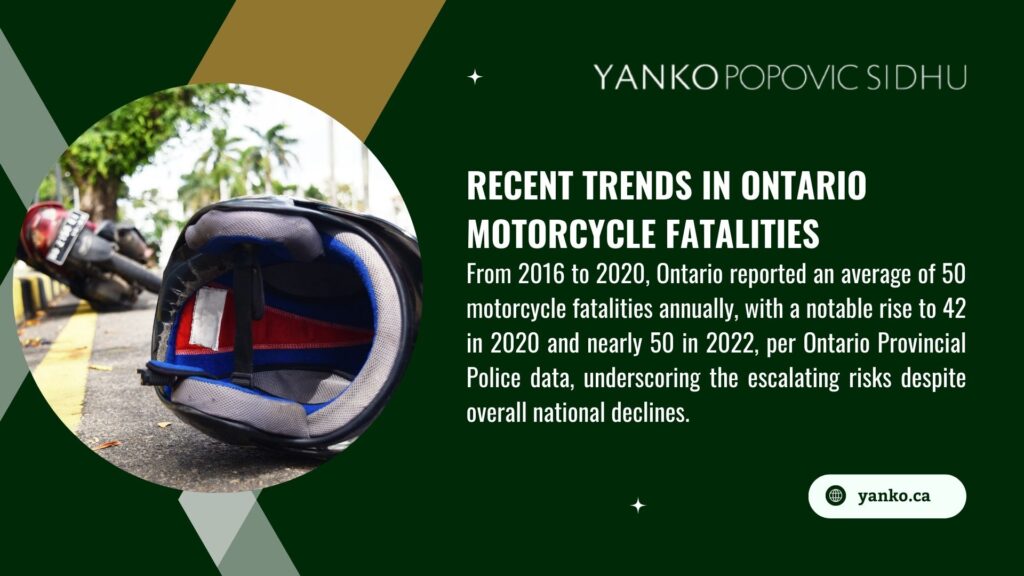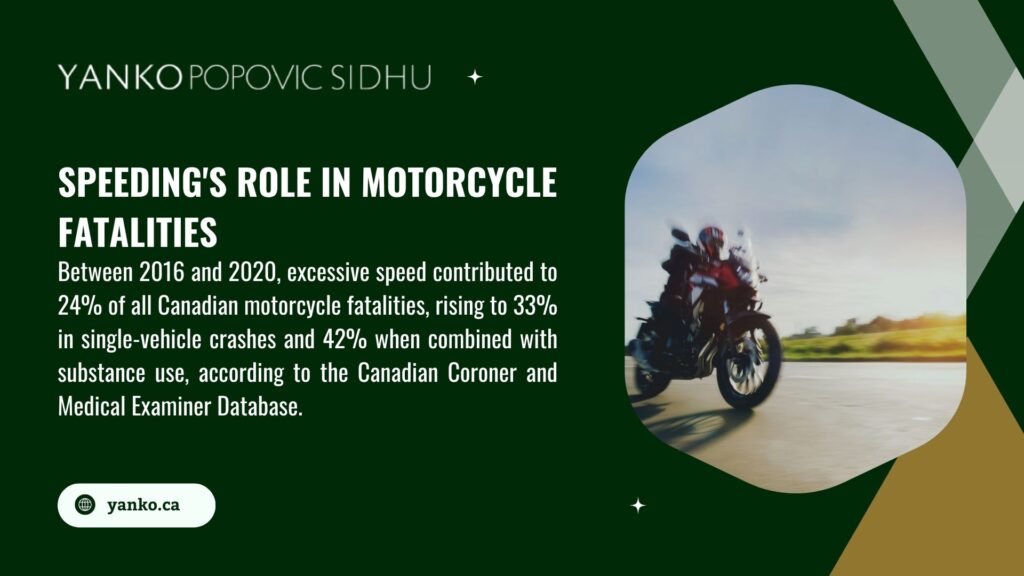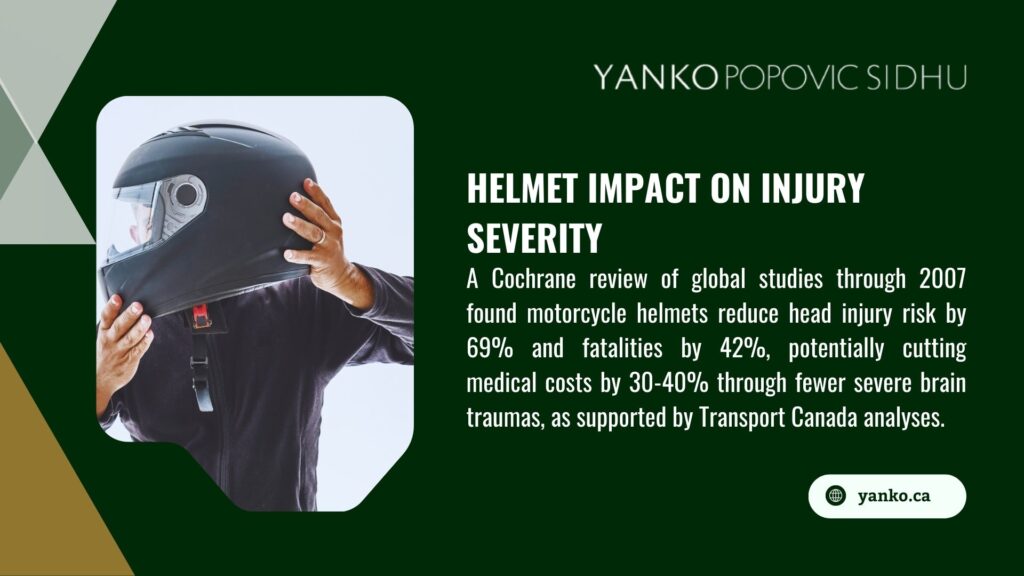Nobody plans to get hurt on their bike. One moment everything’s fine, the next someone’s calling an ambulance and life gets turned upside down.
Canada sees about 180 motorcycle deaths every year, and those are just the fatal crashes. For every death, there are dozens more riders dealing with broken bones, head injuries, and months of recovery.
In Ontario alone, almost 2,200 out of every 100,000 registered bikes end up in accidents with injuries. Compared to cars, motorcycles are nearly three times more dangerous.
So what does this mean for motorcycle accident compensation? Well, the numbers are all over the map. Some settlements are as low as $7,500, others hit $375,000 or more. Most fall somewhere between $10,000 and $100,000, with the average landing around $73,700.
What Counts as Motorcycle Accident Compensation
The Bills and Receipts
Economic damages are the easier part of motorcycle accident compensation to figure out. These are the bills and receipts that pile up after an accident.
Medical bills usually make up the biggest chunk. Emergency room visits, surgeries, hospital stays, physical therapy, prescription drugs – it all adds up fast. Motorcycle accidents often cause serious injuries like brain trauma, spinal cord damage, and broken bones that require months or years of treatment.
Lost wages are another major piece. Some provinces let accident victims recover up to 85% of their regular pay for up to three years while they recover. This includes bonuses, benefits, and other work-related income that gets lost during recovery.
Property damage covers fixing or replacing the motorcycle and any other damaged belongings. Even what looks like a minor motorcycle accident can total a bike or cause major damage since motorcycles don’t have the protective shell that cars do.
Non-Economic Damages
How do courts put a price on pain? Or the depression that sets in after a life-changing injury?
Pain and suffering compensation tries to address the physical discomfort and emotional trauma that comes with serious injuries. Non-pecuniary damages handle these types of losses, though calculating fair amounts isn’t straightforward. Courts look at how severe the injuries were, how long recovery took, and how much the accident changed someone’s daily life.
Mental health impacts are real and costly. Many motorcycle accident victims develop anxiety, depression, or PTSD that requires ongoing treatment. These conditions can last long after broken bones heal.
Loss of enjoyment damages come into play when injuries stop someone from doing things they loved before the accident – playing sports, hobbies, social activities. It’s compensation for the life that existed before the crash.
What’s the Difference?
The law separates pecuniary vs non-pecuniary damages for good reason. Pecuniary damages have receipts and bills to back them up. Non-pecuniary damages require more subjective evaluation of how injuries affected someone’s life.

What Affects How Much Compensation Someone Gets
Different factors can influence how much compensation you get.
How Bad the Injuries Are
This is the biggest factor in determining motorcycle accident compensation. Catastrophic injuries like traumatic brain injuries, spinal cord damage, or amputations typically result in much higher settlements because they require extensive treatment and often cause permanent disabilities.
Common serious motorcycle injuries include severe head trauma that can cause lasting cognitive problems, spinal injuries that may leave someone partially or completely paralyzed, complex fractures that need multiple surgeries, road rash so severe it requires skin grafts, and internal injuries that might not show up right away but can be life-threatening.
Who Was at Fault
Fault matters a lot when it comes to compensation. If the other driver clearly caused the accident, the injured rider might recover full compensation. But if the rider shares some blame, compensation gets reduced accordingly. This is why accident reconstruction and witness testimony become so important.
Insurance Coverage Limits
The at-fault driver’s insurance limits can cap how much compensation is available. Many drivers carry minimum coverage, often just $25,000 per person and $50,000 per accident in some areas. For serious motorcycle injuries, this isn’t nearly enough. Smart riders carry their own uninsured/underinsured motorist coverage to fill these gaps.
Long-Term Impact
Good motorcycle accident compensation accounts for future medical needs, ongoing therapy, lost earning capacity, and permanent disabilities. This requires medical experts to project what treatment will cost over someone’s lifetime and economists to calculate lost future income.

How the Legal Process Works
Right After the Accident
What happens immediately after a motorcycle accident can make or break a compensation case. Getting medical attention right away is crucial, even for injuries that seem minor.
Some serious conditions don’t show symptoms immediately. Documenting the accident scene, getting witness contact information, and being careful about what gets said to insurance companies all matter.
Dealing with Insurance Companies
Insurance companies often approach motorcycle accident claims assuming the rider was at fault. There’s an unfortunate bias that motorcyclists are reckless risk-takers who probably caused their own accidents. Having experienced legal representation helps counter these assumptions and ensures fair treatment.
Why Legal Help Matters
A good motorcycle accident lawyer can make a huge difference in compensation amounts. They know how to investigate accidents thoroughly, gather the right evidence, negotiate effectively with insurance companies, and take cases to trial when necessary. They understand the unique challenges motorcycle accident cases present.
Timing Settlements
One crucial mistake is settling too early. Cases shouldn’t be resolved until someone reaches maximum medical improvement – the point where doctors can say whether disabilities will be permanent. Settling before then often means accepting less money than what future medical care will actually cost.
Special Situations
Medical Issues
Sometimes motorcycle accidents happen because of medical negligence – like when a rider loses consciousness due to an undiagnosed medical condition. These cases might involve both motor vehicle claims and medical malpractice lawsuits.
Hospital Problems
Poor medical care after a motorcycle accident can create grounds for suing a hospital for negligence. If inadequate treatment makes injuries worse or creates new complications, additional compensation may be available.

Getting the Most Compensation Possible
Keeping Good Records
Documentation makes or breaks compensation cases. Keep every medical bill, prescription receipt, therapy record, and note about how injuries affect daily life. Take photos of injuries as they heal. Keep a journal tracking pain levels and limitations.
Medical Evidence Matters
Strong medical evidence and expert testimony significantly impact compensation amounts. Work with lawyers who understand how to present medical evidence effectively and can bring in the right experts to testify about injuries and future needs.
Avoiding Common Mistakes
Several mistakes can cost money: accepting quick settlement offers before understanding the full extent of injuries, waiting too long to get medical treatment, talking to insurance companies without legal representation, and settling before reaching maximum medical improvement.
Settlement vs. Trial
Most cases settle out of court, but knowing when to accept a settlement versus going to trial requires experience and judgment. Good lawyers can evaluate whether settlement offers fairly compensate for all damages.
Get the Help You Need
Insurance companies have teams of adjusters and lawyers working to pay as little as possible on motorcycle accident claims. Injured riders need someone fighting just as hard for them.
Yanko has handled motorcycle accident cases across Ontario for years. We know how these cases work, what insurance companies try to pull, and how to build strong cases that get results. We work on contingency fees – no payment unless we win.







